#Race relations
Text


this is chief among the reasons why i have no respect for black republicans.
#disrespectful black republicans#jim crow era#white approval#historical revisionism#black community#racial injustice#seeking white validation#black conservatives#misrepresentation of history#political pandering#black lives#systemic racism#conservative black voices#white supremacy support#black history distortion#self-hatred in politics#race relations#black identity#minority tokenism#historical denial
400 notes
·
View notes
Text
the people who think james and hbomberguy's whiteness do not matter in this context are just telling how little they know of the workings of race and white privilege in the world. If it didn't matter, that man wouldn't have gotten away with his plagiarism for so long, and creators of color wouldn't have been afraid to speak up against him. Claiming that "race has nothing to do with it" is at best ignorant and at worst malicious, if you go to any environment of cultural production you will find piles of cases of white creators/scholars/whatever failing to give credit to their racialized peers, and a lot of those times these plagiarism cases go hand in hand with other instances of racism. Sorry you get uncomfortable by being made to acknowledge your own privilege, but we're GONNA talk about race in EVERY conversation. SPECIALLY when it involves creation and cultural production.
#hbomberguy#james somerton#plagiarims#racism#race relations#racism in online spaces#racism in fandoms
520 notes
·
View notes
Text

Okay, this is gonna get into some mildly woke shit and references microaggressions immigrants or children of immigrants might have experienced in school. All in the service of trying to work through a headcanon of mine.
I'm fascinated by the idea that Marinette and Kim are (nearly) the only two Asians at their majority-white school in their overwhelmingly majority-white country. (Though obviously Vietnam and China aren't the same country, white people tend to lump all Asian countries together, esp. CJK and Vietnam).
I imagine, based on what I saw in my own childhood, the shared experiences as children of opening up their mom's homemade food for lunch and Chloe walks by "ew yuck that smells bad!" or something. Getting similar comments like "why'd you get a C on the math test? You're all meant to be math wizards!"
Setting that aside, Kim is a himbo, and we never see him have many redeeming behaviors. But Marinette had a crush on him. Yes, he's attractive, tall, athletic, etc. Yes, she was 12yo or something. (Trying to consider various interpretations here.)
But, I'm curious what people's thoughts are on her having a crush on him because she just kinda...heard it enough from people in school. Things like "Oh you should date Kim; you have so much in common!"
It's certainly a known phenomenon of the two Asian kids in school being told some variation of that, that they should date bc they have "so much in common" (translation: your ancestors came from the same continent) I think it might've even been a Claudia-centric plot-line in a Babysitters Club book.
And ever since Derision, I've wondered why they specifically picked the one Asian guy at the school for Marinette to be crushing on.
#marinette dupain cheng#marinette dupain-cheng#miraculous ladybug#headcanon#race relations#woke shit#racism#colonialism#internalized racism#kim le chien#immigration#children of immigrants
15 notes
·
View notes
Text
#black history#blacklivesmatter#black lives matter#haiti#haitians#free haiti#black excellence#black women#black people#racial injustice#voting#vote blue#vote democrat#vote harris#get out and vote#race relations#racism#immigrants#immigration#springfield ohio#kamala 2024#kamala harris#vote kamala#haitiansforkamala#donald trump#jd vance#haitian immigrants#voter registration#voter suppression
8 notes
·
View notes
Text
i learned that from the 1990s through 2021 the NFL used a method called "race-norming", which assumed Black players started out with lower cognitive function, as part of a dementia test to determine payouts in brain injury settlements (x)
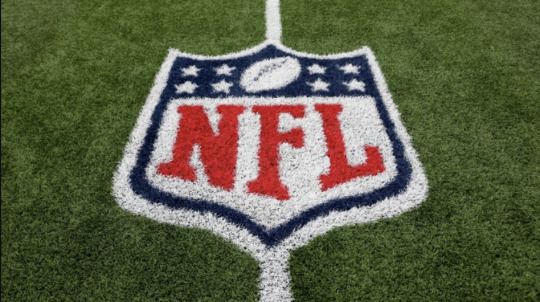
155 notes
·
View notes
Text
UK folks please stay safe! Fellow Muslims, poc and other minorities, we must band together to protect our communities.

#uk riots#uk#united kingdom#england#race relations#islam#islamophobia#racism#British muslims#uk muslims
9 notes
·
View notes
Audio
Listen/purchase: Water Fountains by Highway 80 Stories
During Mike Broussard’s early childhood, his family lived in Shreveport, Louisiana, but later he moved to Vivian where he owned a business and lived out the remainder of his life. The experience described in this song, when Mike was twelve years old, affected his attitude towards race relations from then on.
One of the oldest movie theaters in Shreveport was The Strand. It had different entrances for blacks and whites and water fountains marked for the different races, as well.
During the ’60s, most southern cities had two simultaneous phenomena: demographically a significant percentage of the population was African-American (Shreveport was about 60% black) and as a consequence whites and blacks unofficially interacted a lot. The other aspect was a policy of official segregation. This manifested itself in a myriad of ways beyond the obvious, e.g. separate drinking fountains and different entrances to movie theaters. However, relationships between whites and blacks could be warm and friendly despite official segregation.
Into the demographic mix were other ingredients. Louisiana had a relatively large number of Italian Americans, mostly Sicilians. These immigrants also experienced some discrimination, and in general did not share the otherwise pervasive white attitudes about African-Americans.
When Mike Broussard served in Vietnam he met an African-American from Detroit, D.W. Washington, and they became life-long friends. Mike and D.W. talked about their plans when their tours were over, and D.W. went back to Vivian with Mike and they operated a filling station and auto repair shop for more than forty years. D.W. was Mike’s closest friend.
© 2019 Frank David Leone, Jr./Highway 80 Music (ASCAP). The songs and stories on the Highway 80 Stories website are works of fiction. Names, characters, businesses, places, events, locales, and incidents are either the products of the author’s imagination or used in a fictitious manner. Any resemblance to actual persons, living or dead, or actual events is purely coincidental.
#bandcamp#literature#southern fiction#short stories#20th century history#the 1960s#race relations#coming of age#Shreveport#Louisiana
32 notes
·
View notes
Video
youtube
Why Some People Do Not Like Kamala Harris
#youtube#amir odom#kamala harris#donald trump#election 2024#united states#race relations#politics#2024 elections#2024 presidential election#opinions on politics#politicians
4 notes
·
View notes
Text

🤔
#race#race relations#identity politics#blm#barack obama#obama#us#usa#united states#politics#blacklivesmatter#gallup#2013#2014#liberal#liberals#democrat#democrats#democratic party#progressivism#progressive
45 notes
·
View notes
Text

The white privilege thing doesn't seem that great when you stop comparing white people with just the worst performers
10 notes
·
View notes
Text
the lies white people tell themselves to escape accountability and a real adult conversation on race, racism and history is just so sad smfh
#racism#white supremacy#historical revisionism#african american history#slavery#accountability#race relations#america's racial history#denying responsibility#white guilt#racial injustice#truth about slavery#escaping accountability#discussing race#confronting racism#avoiding guilt#historical lies#american slavery#race discussion avoidance
387 notes
·
View notes
Text

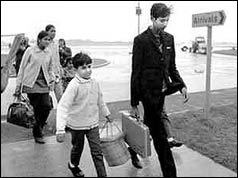
On 18th September 1972, BBC News reported that the first 193 Ugandan refugees, fleeing persecution by the country’s military dictatorship, had arrived at Stansted Airport, Essex. Over half of the arrivals had British passports, and housing and immediate needs would be overseen by the Ugandan Resettlement Board.
Uganda’s Asian community, numbering around 55 000, many of whom ran family businesses and small enterprise, were ordered in August 1972 to leave the country within 90 days by President Idi Amin. Amin had publicly denounced Ugandan Asians as ‘bloodsuckers’, threatening that any who had not left by the arbitrary deadline of November 8th would be interned in military detention camps.
Many of the initial flight of refugees had endured frightening experiences prior to their departure from Uganda, at the hands of Amin’s troops. "On the way to the airport the coach was stopped by troops seven times, and we were all held at gun point," one refugee told reporters. Another stated that he had been robbed of personal valuables and Ugandan currency on the way to Entebbe airport.
News reports at the time cited some opposition within the UK over the acceptance of the Ugandan Asians. The Leicester local authority mounted a newspaper campaign urging refugees not to come to their region seeking jobs and housing. The BBC asserted that, in hindsight, the resettlement programme was seen as ‘a success story for British Immigration’.
The loss of the hardworking and successful Ugandan Asian community devastated Uganda’s agriculture, manufacturing and commerce. Idi Amin was deposed in 1979 and died in Jeddah in 2003, having been responsible for the deaths of as many as 300 000 Ugandan civilians during his reign of terror as President. In 1991, Ugandan President Yoweri Museveni invited the expelled community to return home to help rebuild the economy.
The Wilson Labour government also had to grapple with a refugee crisis from a former African colony.
In February 1968, BBC news reported;
"…Another 96 Indians and Pakistanis from Kenya have arrived in Britain, the latest in a growing exodus of Kenyan Asians fleeing from laws which prevent them making a living…"
Many Asian people living in Kenya had not taken up Kenyan citizenship following the country’s independence from Britain in 1963, but possessed British passports. Under Kenya’s Africanisation policy, non-citizens required work permits, and were being removed from employment in favour of Kenyan nationals. There was growing public demand for laws to prevent non-citizens from owning businesses or even operating as street and market traders. As a result, British passport holders were leaving Kenya at the rate of 1000 per month, leaving a huge deficit in skills and experience within the business community and civil service.
Fearing a backlash over the large numbers of Asian immigrants, Home Secretary, and future Prime Minister, James Callaghan, rushed through the Commonwealth Immigration Act, which made it a requirement that prospective immigrants must have a 'close connection' with Britain.
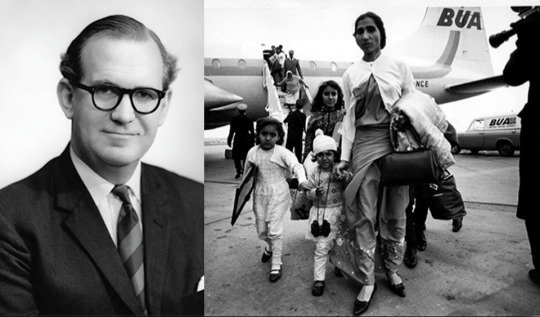
This led to disagreement in Cabinet, with Secretary of State for Commonwealth Affairs, George Thomson (1921-2008) arguing;
"…To pass such legislation would be wrong in principle, clearly discrimination on the grounds of colour, and contrary to everything we stand for…"
In 1971, the Heath government made further legislative changes that would mean that (some) immigrants from Commonwealth countries would be treated no more favourably than those from the rest of the world, and that tightened restrictions on those who stayed by linking work permits to a specific job and location, requiring registration with police, and reapplication to stay in Britain each 12 months.
The Patrial Right of Abode lifted all restrictions on those immigrants with a direct ancestral connection with Britain.
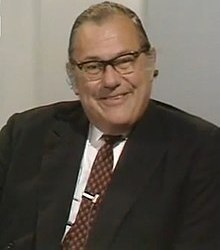
Home Secretary Reginald Maudling (later famous for being smacked in the face by Irish MP Bernadette Devlin, and for having to resign over a corruption scandal linked with disgraced property developer John Poulson) denied that this was, in effect, a 'colour bar', telling the BBC;
"…Of course they are more likely to be white because we have on the whole more whites than coloureds in this country, but there is no colour bar involved…"
Unsurprisingly, not everyone was convinced.
Vishna Sharma, Executive Secretary of the Joint Council for the Welfare of Immigrants, described the bill to BBC News as, "basically racially discriminatory, repressive and divisive," and added, "It will create divisions amongst the Commonwealth citizens already living in this country on patrial and non-patrial basis. It will create day-to-day bureaucracy and interference on people living in this country. It will create more hardship for people wanting to enter into this country."
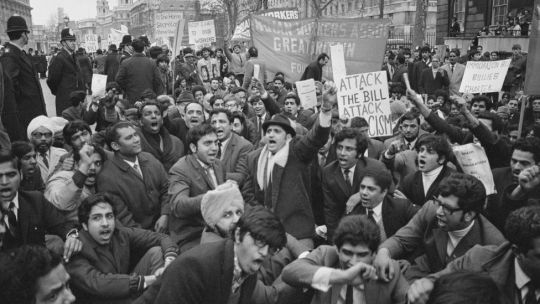
(Source; BBC reporting and history.com. Photo Credits; BBC News)
#social history#uk politics#working class history#social justice#uk government#human rights#uk history#british culture#society#history#race relations#immigration
27 notes
·
View notes
Text
youtube
Coleman Hughes on the Politics of Race | Real Time with Bill Maher
Bill Maher: So, what's the difference, where do we draw the line here? Fighting racism and your book is fighting the politics of ra-- -Talking about the politics.
Coleman Hughes: Right.
Maher: What's the difference between fighting racism and the politics of racism?
Hughes: Right. So, racism as defined by Martin Luther King, the Civil Rights Movement, judging people on the basis of their race, rather than their character and so forth. That's not what my book is-- is against, uh, fighting. Obviously, we should all fight that. No matter who it's directed at.
What my book is fighting is this ideology that really was born with critical race theory, the adult version of critical race theory in the '70s and '80s and became more popular over the past ten years. That equates Whiteness with evil, equates Blackness with a kind of moral superiority. Stereotypes whole groups of people, says that your race is an essential part of who you are and feels even that children need to be taught this from as young an age as possible because they're-- they're born with the wrong attitude about race and it needs to be sort of hammered out of them, by separating White kids from Black kids, from Hispanic kids. Putting them in different corners of the room, as was done in my Columbia University orientation, some nine years ago. And that the way we're going to get to, you know, the kind of society we want is by focusing more and more on racial identity.
In my book I say, this is nonsense, this is totally against the spirit of-- of the Civil Rights Movement and that actually, the wise principle is that we should try to treat people without regard to race both in our personal lives and in public policy.
Maher: Funny, I mean… that wouldn't have been controversial with any liberal, 30 or 40, 50 years ago. I mean, that is what Martin Luther King said. What-- what color blind society, I mean, I thought we were all after that and then we all weren't, and what changed?
Hughes: Yeah, so, even 20 years ago, it wouldn't have been controversial. I grew up in a liberal town, Montclair, New Jersey, many people probably know it. Diverse town, where, you know, we celebrated Martin Luther King every year, we listened to the famous speech and got goosebumps, as most Americans do and really believed that, uh, and I lived out that dream, in other words, I had friends of every race as a kid and I didn't think of them as belonging to a race, I thought of them by their name and their attributes, right? Around--
Maher: They treated the same way?
Hughes: Yeah. For the most part. Yeah, I mean, there are exceptions, but the exceptions prove the overwhelming rule. So, you know before 2013, you can just look at polling data from Gallup and Pew. The majority of Americans, Black, White and Hispanic believed race relations were good, as late as 2013. And that's the year everything takes a nosedive, so that by 2021, half as many people thought we were in a good place, as thought that in 2013.
So, the question is what happened? Did racism suddenly spike? Well, no, the data is pretty clear on that, racism didn't spike, what happened is that, we all got smartphones and social media, and started seeing unrepresentative video clips of cops, you know, harassing or beating or killing Black Americans and this gave people the misperception that racism was suddenly this widespread problem and it touched off all of these trends that we've now heard about for the past eight years, under various names, wokeness, CRT, DEI, it's all fundamentally from that core change and how information is being shared.
Maher: But there was part of that was good, that we did see these beatings and things go on, because that's what changed it.
Hughes: The one thing I can say is good about it, is before the Black Lives Matter movement in 2013, cops could basically do whatever and not get punished.
Maher: Right.
Hughes: You could, I mean-- it's hard to find even a single example. Uh, you can find isolated ones but mostly cops got away with whatever. So, that's no longer the case and that's the one thing I could credit.
Maher: And they go to jail.
Hughes: Yeah. I mean it-- But on the other hand, it has not-- many people think it just revealed all the racism that's actually out there, that's not true, because if that were true, people would have an accurate assessment, and this has been tested. When you ask very liberal Americans, "How many unarmed Black people do you think are shot by the cops every year?" The answer they gave in 2019 was a thousand, the real number from that year was 12. So, this social media algorithmically boosted content has-- it's not educating us, it's miseducating us.
--

#Coleman Hughes#Bill Maher#Real Time with Bill Maher#race relations#racism#antiracism#antiracism as religion#critical race theory#woke#wokeness#cult of woke#wokeism#wokeness as religion#social media#religion is a mental illness
6 notes
·
View notes
Text
The Landlord, 1970. x
#the landlord#black films#black power#anti white supremacy#black is beautiful#1970s#1970s films#race relations
5 notes
·
View notes
Text


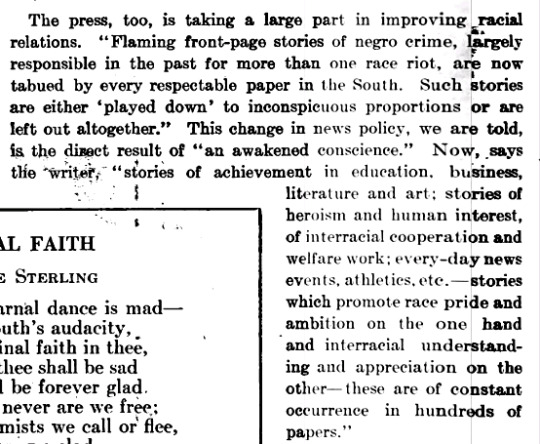

LITERARY DIGEST, February 12, 1927
7 notes
·
View notes
Text

THE DESCRIPTION OF SAINT MARTIN DE PORRES
The Patron of Barbers (and Hairstylists), Race Relations and Social Justice
Feast Day: November 3
"Do not complain, that shows discontent with the will of God in the present moment. That is also proof of impatience."
Martin de Porres was born in Lima, Peru, on December 9, 1579 to Don Juan de Porras y de la Peña, a Spanish nobleman and adventurer, and Ana Velázquez, a freed daughter of slaves from Panama. His father abandoned the family when Martin and his sister, Juana, were very young. Ana Velázquez supported her children by taking in laundry.
Martin's childhood poverty did not embitter him but made him sensitive to the plight of the poor, and especially the orphans to whom he would devote much of his time and resources. Even as a child, Martin would give the family's scarce resources to the beggars whom he saw as less fortunate than himself.
When Martin turned eight, his father had a change of heart and decided to claim his two children (publicly identified as mulatto, a term used for mixed-race children) in spite of the gossip to which it subjected him. He made sure that both were afforded a good education and had enough money for the family not to suffer hardship. At the age of twelve, Martin began an apprenticeship with a barber/surgeon named Marcel de Rivero. He proved extremely skilful at this trade and soon customers, who at first were sceptical of the young coloured boy, came to prefer and ask for him.
After leaving home, Martin took a room in the house of Ventura de Luna. Always a devoted Catholic who spent much time in church, Martin begged his landlady for some candle stubs. She was curious about his activities and one night spied on him through a keyhole and witnessed Martin in a vigil of ecstatic prayer — a practice he would continue throughout his life.
Martin often challenged his brothers on their racial attitudes. In one story, Martin came upon a group of Indians sweeping the floor under the watchful eye of one of the Dominican brothers. When told that they were cleaning to repay a meal they had received, Martin pointed out that the brother had fed some white people the previous day without forcing them to clean. After Martin's firm but gentle challenge, the brother took up the broom himself.
Martin frequently insisted on performing such hard and menial tasks as caring for the Order's horses in the evenings, even when informed that servants were available for these chores. He would argue that the servants were tired from their day's work while he, Martin, had done very little. He also extended his healing gifts — going to the servants' quarters and treating their ailments.
Martin's spiritual practices were legendary. He would often fast for extensive periods of time on bread and water. He loved all-night vigils, frequently praying by lying down as if crucified, sometimes kneeling but, miraculously, a foot or more off the floor. Equally legendary was his love of animals. He would feed and heal all animals that came into his vicinity and they understood and obeyed him.
Martin is often portrayed with mice because, according to one story, the monastery was tired of their rodent problems and decided to set traps. Martin was so distressed that he spoke to the mice and cut a deal with them that if they would leave the monastery, he would feed them at the back door of the kitchen. From that day forward, no mouse was seen in the monastery.
However, it is Martin's charity that made him the patron saint of social justice. Martin fed, sheltered and doctored hundreds of families. He also provided the requisite dowry of 4,000 pesos to enable at least 27 poor young women to marry. Last, but not least, he established the Orphanage and School of the Holy Cross, which took in boys and girls of all classes and taught them trades or homemaking skills. Over much criticism, he insisted that the school staff be well-paid so that they would give their best service.
Martin died on November 3rd, 1639 at the age of 59 in Lima. He died surrounded by his brothers and reciting the Credo, his life ending with the words 'et homo factus est (He had became man)'.
His funeral was attended by thousands of Peruvians from all walks of life who vied to get a piece of Martin's habit as a relic. These pieces of the saint's habit have been associated with innumerable miraculous cures. Martin de Porres is buried in the Convento Santo Domingo in Lima, Peru.
#random stuff#catholic#catholic saints#dominicans#order of preachers#barbers#hairstylists#race relations#social justice#lottery winners#martin de porres#martín de porres velázquez
9 notes
·
View notes